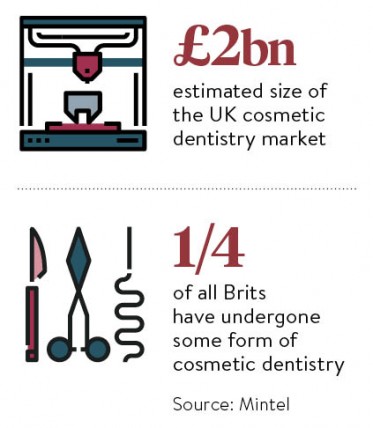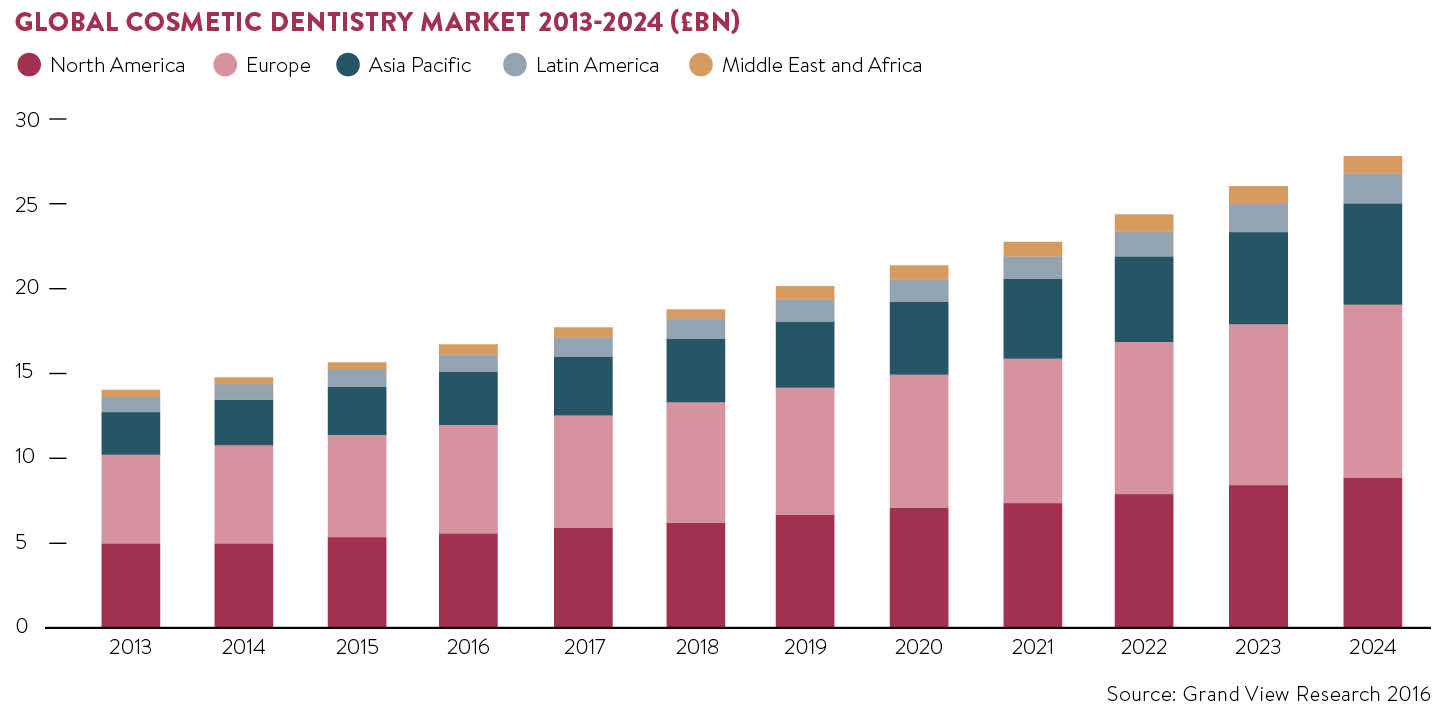Both men and women rate smiles and teeth as the second most important attractive feature, with personality in the top slot, so the Oral Health Foundation tells us.
That our awareness of this concept has risen in previous years is borne out by the fact that a quarter of Brits have undergone some form of cosmetic dentistry, with the industry worth about £2 billion, according to market research company Mintel.
So what does aesthetic dentistry have to offer the discerning dental patient both now and potentially in the not-too-distant future?
Tooth whitening has become one of the most popular treatments, as the approved bleaching process is relatively affordable and effective.
 While some dentists will advocate more futuristic-looking “power” bleaching in the dental practice, whereby a light is shone to stimulate the active ingredient, others will consider home-whitening the best bet; it all depends on individual circumstances.
While some dentists will advocate more futuristic-looking “power” bleaching in the dental practice, whereby a light is shone to stimulate the active ingredient, others will consider home-whitening the best bet; it all depends on individual circumstances.
The key to a successful outcome is to consult with a fully qualified dental professional registered with the General Dental Council. It is important to note that it is illegal for anyone other than a dentist, or a dental hygienist or therapist working to a dentist’s prescription, to carry out tooth whitening, so beware anyone claiming otherwise.
Meanwhile, for many the idea of orthodontic treatment brings to mind years of discomfort and unattractive metal stuck on to the teeth.
Today’s technology, however, allows that perception to be placed in the dim and distant past, with short-term teeth straightening claiming a well-earned place among the growing uptake of life-enhancing treatments.
Veneers
Suitable for adults who require relatively simple tooth movement, aesthetic results can be achieved in about six months using a series of almost imperceptible removable aligners, so not only will most people not notice, but also there will be no limitations on the wearer’s ability to keep their teeth and gums clean and healthy throughout the process.
It’s no secret that veneers have been the go-to for many a celebrity looking to improve their smile in one easy step, and it is equally accessible to any one of us looking to correct defects such as gaps between teeth, discolouration and crooked smiles.
Veneers are individually handcrafted by dental technicians and placed on top of the existing teeth, creating a natural and lasting smile; if looked after well, they can last a good ten to fifteen years.
What’s more, new materials have allowed veneers to become thinner and thinner, so no tooth preparation is required and therefore the outer surface of the teeth does not need to be trimmed back. There are, however, some limitations and considerations beyond aesthetics, so they are not suitable for everyone.
The concept of lasers in dentistry might seem like it belongs in the future, but they are already being used to good effect to enhance cosmetic treatments.
For example, a patient opting for veneers may well benefit both aesthetically and functionally if they have a low or uneven gum line. Reshaping the gums can help achieve a neater look, more in proportion with the teeth.
Fabricating items layer upon layer, 3D printers enable replacement teeth to be created to an exacting, natural-looking standard
A simple procedure for a qualified cosmetic dentist or gum specialist to carry out, soft tissue gum sculpting using a laser typically requires one visit of about an hour. Local anaesthesia is usually administered to the area to be treated, and the laser then used to trim, reshape and re-seal the gums, as necessary. However, it should be pointed out that the use of lasers by dentists is not regulated.

3D tooth printing
Perhaps one of the most exciting innovations in the pipeline is that of 3D tooth printing. In the past dentists with the right technology have been able to create new teeth chairside using scanners, 3D-modelling software and a block of a suitable material such as one made of ceramic.
However, 3D printers are poised to offer a revolution in tooth creation. Fabricating items layer upon layer, 3D printers enable replacement teeth to be created to an exacting, natural-looking standard.
As with any new technology, time and cost barriers are slowly being overcome, while a necessary next step is to ascertain the efficacy of these teeth within the oral cavity, to check how they fare alongside millions of microbes. To this end, the possibility of fabricating 3D teeth with antimicrobial properties is already being explored.
Commenting on technology and smile aesthetics, Dr Patrick Holmes, president of the British Association of Aesthetic Dentistry, says: “In recent years there has been recognition, both from dentists and the public, that having unsightly teeth is not just a matter of vanity. If you do not have confidence in your smile, it can affect your behaviour and self-assurance. Cosmetic dentistry has a wealth of techniques and materials which, applied correctly, can make a very positive impact on people.
“Unfortunately, at the moment the General Dental Council has not yet created a specialist list for those who have concentrated their skills in this area. If you are seeking treatment, a personal recommendation can be invaluable. Furthermore, never be afraid to ask what postgraduate training the dentist proposing the treatment has had in this field, so that you are comfortable they are able to offer the most appropriate, scientifically backed treatment, tailored to your needs.
“We would also recommend that, before any treatment is undertaken, there is full understanding of what will be done and the long-term implications.”
There is no doubt that 21st-century technology allows dental professionals to be more than the guardians of oral health. Whether patients are looking for a subtle change or a complete smile makeover, today’s equipment and techniques can help to achieve a healthy, visually appealing smile, with plenty more to come, when they place themselves in the hands of a qualified dental professional.

Veneers

